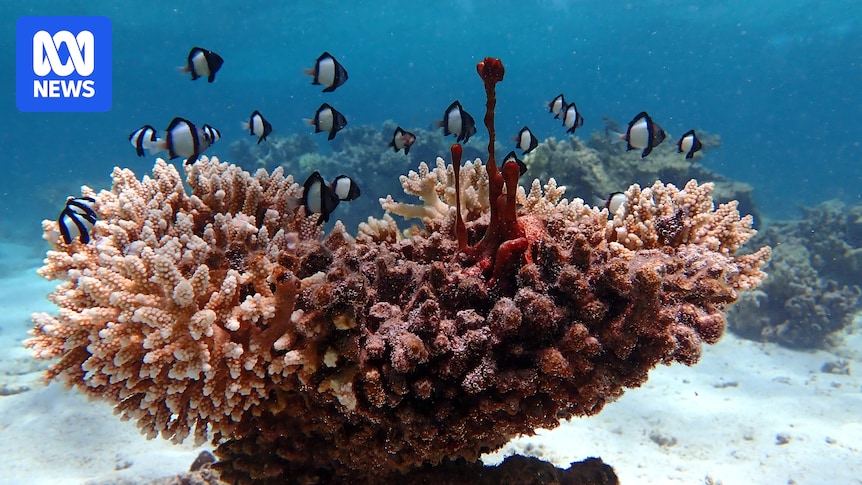On Western Australia’s Ningaloo Reef, the shift from stark white to sickly brown paints a dire picture.
“It’s a really dramatic change from all the colour and the vibrancy that a healthy coral shows,” marine scientist Zoe Richards said.
“We’ve shifted to this dull phase where it’s algae dominating the corals.”
Of the 1,600 corals counted earlier in the year, only 600 are still alive. (Supplied: Minderoo Foundation)
The most recent survey by researchers from Curtin University shows that more than 60 per cent of corals at eight sites in the reef’s northern lagoon have died.
Of the 1,600 corals counted in March, only 600 were still alive come late October.
The researchers returned to eight sites spanning 40 kilometres, identified during the marine heatwave. (Supplied: Minderoo Foundation)
The survey area stretched 40 kilometres from the Osprey and Tantabiddi sanctuary zones, an area that includes Turquoise Bay and several of the reef’s most popular tourist spots.
The findings mark a new phase for the World Heritage site, which was gripped by its worst-ever bleaching event earlier this year.
Scientists warn ocean temperatures off WA are already warmer than average, with the summer months set to be “incredibly critical” for the remaining corals to hang on.
Coral bleaching vs mortality
When the ocean get too hot, corals expel the zooxanthellae algae that lives in their tissue.
‘Hope spot’ to ‘skeletons’: Ningaloo’s ‘catastrophic’ event
These microorganisms give corals their bright pastel colours and disease resistance.
Their absence creates the bleaching effect many Australians have become all too familiar with.
Unlike its east coast cousin, the Great Barrier Reef, the 270-kilometre Ningaloo Reef largely escaped the impact of climate change-induced ocean warming.
Coral taxonomist Zoe Richards says the change has been “dramatic”. (Supplied: Minderoo Foundation)
But a record heatwave since December 2024 has flipped that fact in the extreme.
“The corals that were bleached earlier in the year have unfortunately succumbed to the heatwave and they have died,” Dr Richards said.
“Now, they are literally turned to rock with algae growing on top of them, it’s very sad.”Left ‘speechless’
PhD candidate David Juszkiewicz said it was not until researchers explored the reef at depth that they realised the extent of the decay.
“It’s when you scuba-dive and go down, you realise that there’s a lot of death underneath,” he said.
PhD student David Juszkiewicz says he is “really concerned” about the summer to come. (Supplied: Minderoo Foundation)
Mr Juszkiewicz compared the scene to walking through a forest after a bush fire.
“All the understorey vegetation, everything is burnt-out and charred,” he said.
“We’re speechless. There [are] no words that can explain what we saw.”
Some species were thought to be totally extinct from the sites surveyed. (Supplied: David Juszkiewicz)
Dr Richards said the ripple effect of the coral death was yet to be understood.
The eight lagoon sample sites with a large number of coral deaths were located between Tantabiddi and Osprey. (Google Earth: Data SIO, NOAA, US NAVY, NGA, GEBCO, Image Landsat, Copernicus)
“We’ve lost a lot of the diversity on the reef, the complexity,” she said.
“The coral is providing habitat for fish, for crustaceans, for shells, for worms … it’s quite likely they have all died.”
Dr Richards said the death of the corals was “just the beginning”.
“This summer and all the summers to come over the next decade are incredibly critical for these reefs to recover,” she said.
There was some hope, however, with corals in the nearby Exmouth Gulf showing signs of resilience.
Towards the reef’s southern tip, deep corals at Coral Bay appeared to escape the brunt of the marine heat.
Much of the bay’s inner section was damaged by an anoxic event in 2022.
Crucial window ahead
The creep of rising water temperatures was first detected off WA’s coast about a year ago.
Principal research scientist at the Department of Biodiversity, Conservation and Attractions, Tom Holmes, said the summer months were expected to be less severe.
DBCA’s Exmouth Gulf marine coordinator Sallyann Gudge surveying sites of coral mortality this week. (Supplied: DBCA)
The department’s marine science team is in Exmouth, conducting surveys of its own.
“At the same time, in November of 2024, we were already seeing significant build-up of heat stress in the Kimberley, north-west atolls, and even down into the northern Pilbara,” Mr Holmes said.
“We’re looking probably slightly above average coming into [this] summer, but in the range of 0.4 to 0.8 degrees.
“It probably wouldn’t move into the bleaching threshold categories … [although] these are still predictions at this point in time and things can change.”
A record heatwave last summer bleached many of the reef’s famous corals. Few have survived. (Supplied: Brooke Pyke)
Pockets of hot water holding on from last year’s event remained a concern, particularly in the state’s south.
“A lot of residual heat was actually retained down in the south-west of WA and that really hasn’t cooled coming into this new summer,” Mr Holmes said.
“So, we’re already looking down at the south-west and seeing some significant heating already starting to occur there.”
Rallying for action
Exmouth glass-bottom boat tour operator Craig Kitson said the rotting corals had left him feeling “absolutely helpless”.
“The best way I can describe it is if you went out in your backyard and you saw your backyard dying and you didn’t know why and there’s no fix for it,” he said.
Exmouth tour operator Craig Kitson met with Environment Minister Murray Watt in Canberra last week. (Supplied: Australian Conservation Foundation)
Last week, Mr Kitson joined a delegation of regional Australians invited to Canberra by the Australian Conservation Foundation to lobby for stronger environmental protection reforms.
He said the situation on the Ningaloo Reef threw the federal Coalition’s decision to formally drop its net-zero commitment in sharp relief.
“It’s going to need some strong leadership to make the right move because we’re staring down the barrel of of the pointy end of climate change,” he said.

